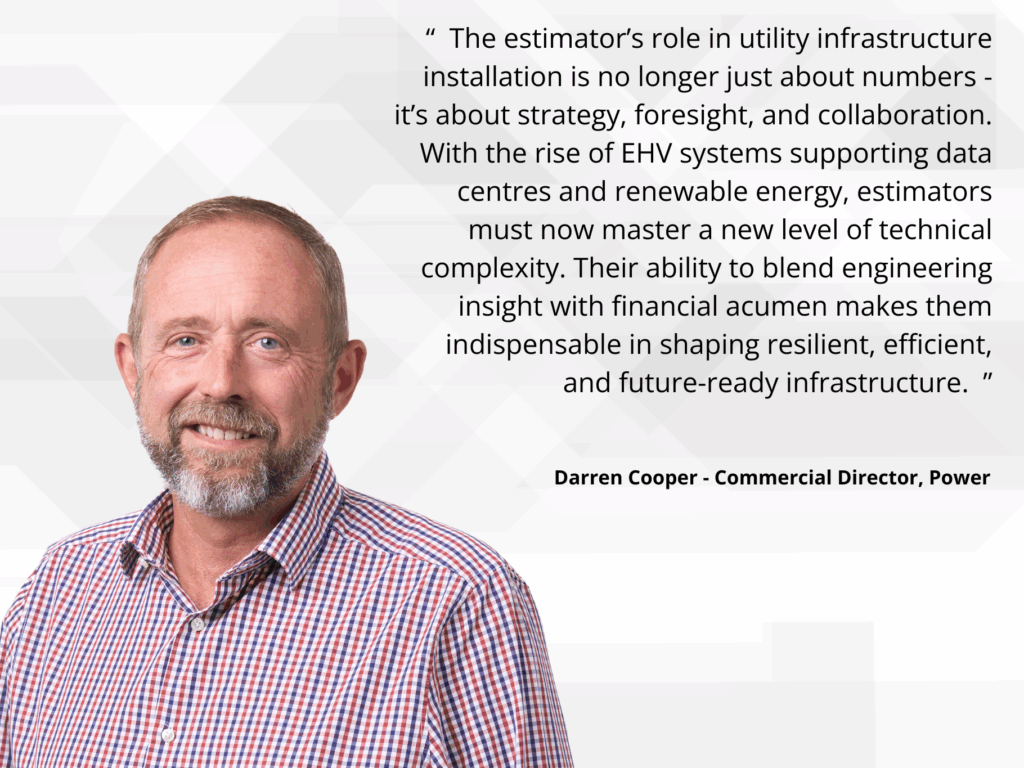With over 37 years of experience in the electrical industry, Darren Cooper oversees all commercial operations within the pre-construction business, including managing a team of electrical estimators. He ensures tender bids are accurately prepared and submitted on time, and is responsible for delivering high standards of customer service and operational efficiency, making sure the division meets its commercial objectives while upholding professionalism and client satisfaction.
The role of the estimator in utility infrastructure installation – especially in sectors like energy and telecommunications – has evolved dramatically over the past decade. Once confined to calculating costs and compiling spreadsheets, today’s estimators are strategic contributors to project planning, risk mitigation, and technological integration. This transformation reflects broader shifts in the industry, driven by digital innovation, regulatory complexity, and sustainability goals.
From cost calculator to strategic planner
Traditionally, estimators focused on quantifying materials, labour, and equipment to produce accurate bids. Their work was largely reactive, based on historical data and standardised pricing models. However, as utility projects have grown more complex – with tighter timelines, diverse stakeholders, and evolving technologies – the estimator’s role has expanded.
Modern estimators are now embedded in the early stages of project development. They collaborate with engineers, project managers, and procurement teams to shape scope, assess feasibility, and forecast risks. Their insights influence design decisions, budgeting strategies, and even regulatory compliance. In essence, the estimator has become a linchpin in ensuring utility projects are delivered on time, within budget, and aligned with strategic goals.
Skills for the modern estimator
To thrive in this new landscape, estimators must possess a broader and more sophisticated skill set:
- Digital fluency: Proficiency in cost estimation software (e.g. ConQuest, Causeway), BIM tools, and cloud-based collaboration platforms is essential.
- Data analysis: Estimators must interpret historical data, market trends, and predictive models to refine estimates and anticipate cost fluctuations.
- Regulatory knowledge: Understanding environmental regulations, safety standards, technical standards and permitting requirements helps estimators account for compliance costs and avoid delays.
- Communication and collaboration: Estimators must work closely with cross-functional teams, presenting findings clearly and negotiating scope changes effectively.
- Risk management: Identifying uncertainties – such as supply chain disruptions or labour shortages – and building contingencies into estimates is now a core responsibility.
The rise of Extra High Voltage (EHV) expertise
One of the most significant recent developments in utility infrastructure is the surge in demand for extra high voltage (EHV) installations. This is largely driven by two forces: the proliferation of data centres and the rapid expansion of renewable energy sources.
- Data centres, with their massive energy requirements and need for uninterrupted power, often require direct connections at EHV on to distribution and transmission networks operating at 132kV and above. Estimators must understand the unique challenges of EHV installations, including specialised equipment, installation standards, and spatial constraints.
- Renewable energy projects, such as large-scale solar farms and offshore wind installations, increasingly feed into the grid at EHV distribution and transmission-level voltages. Estimators must be able to assess the cost and complexity of connecting these sources to existing infrastructure, often across remote or difficult terrain.
As a result, estimators now need to be fluent in EHV design principles, substation configurations, and transmission line construction. They must also factor in advanced protection systems, grid compliance requirements, and long-term maintenance considerations. This expertise ensures accurate budgeting and risk assessment for projects that are critical to national energy strategies.
Influences shaping the role
Several key influences are driving this evolution:
- Technological advancement: The rise of smart grids, renewable energy systems, and digital twins has introduced new variables into utility projects. Estimators must understand these technologies to assess their impact on cost and schedule.
- Sustainability and ESG: Projects are increasingly evaluated through environmental, social, and governance (ESG) lenses. Estimators must factor in carbon footprints, energy efficiency, and long-term operational costs.
- Economic volatility: Fluctuating material prices, inflation, and global supply chain issues require estimators to be agile and informed.
- Workforce dynamics: Skilled labour shortages and changing workforce expectations influence labour cost assumptions and scheduling.
These factors demand that estimators remain adaptable, informed, and proactive.
View out latest Estimator vacancies.


